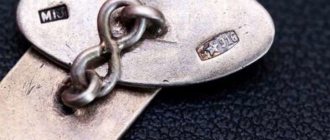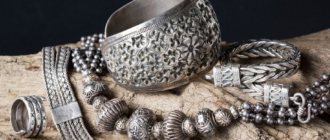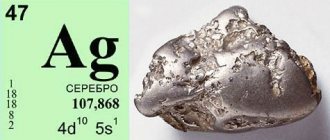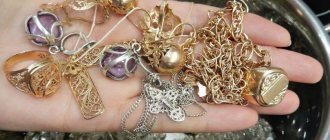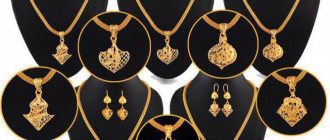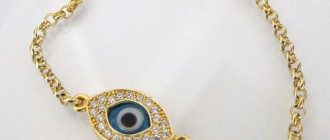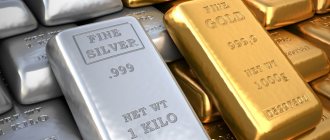Apart from the traditional jewelry industry, precious metals also find their use in electronics and many industrial applications. They are famous not only for their unearthly beauty and shimmer, but also for their high strength and resistance to external influences. The value of these metals is also explained by the fact that they are not so easy to find in nature.
Known noble metals
Noble metals are gold, silver and platinum, which are known to us mainly from the jewelry industry. They have several derivatives (rhodium, iridium, palladium, ruthenium, osmium), which can also be classified in this category. However, there is no consensus among scientists about the completeness of this list. Thus, a number of researchers believe that technetium also complements noble metals. Its peculiarity lies in its radioactivity.
Jewels have gained this status due to the fact that they are practically not susceptible to corrosion, as well as to the influence of most chemical elements. For jewelry, not only shine and shimmer are important, but also the fact that precious metals practically do not enter into any reactions with the human body, and therefore do not lose their properties over time and do not lead to inflammation and allergic reactions. Their cost also increases due to the fact that they are quite rare in nature.
Healing properties
Even in ancient times, people were convinced that solar metal had healing properties.
- Affects the human nervous system.
- Relieves inflammatory processes.
- Relieves allergic reactions.
- Increases brain activity and endurance.
- Improves memory.
- Improves mood.
- Protects from the evil eye and evil slander.
- Eliminates stress.
Moreover, to get rid of ailments, it is enough to simply wear gold jewelry constantly. Even ancient people believed that gold perfectly prolongs the life of its owner.
Characteristics of platinum and its derivatives
The group of noble metals is characterized by increased strength, electrical and thermal conductivity, and resistance to destruction. However, each of them also has some features that give them special value. So, speaking of rhodium, it is worth noting its silver-blue hue. Despite the fact that it is quite resistant to chemical reactions, mechanical influences have a destructive effect on it. However, it is the most expensive metal on the planet, and its price can exceed $200 per gram.
The second most valuable gold metal is platinum. Its price is 30-40 dollars per gram. Neither air nor any aggressive chemicals can oxidize this substance. Since platinum is extremely rare in natural conditions, it is combined with other metals.
Osmium is the heaviest of all known precious metals. Its color is close to white with a barely noticeable silver tint. It is worth noting that it cannot be obtained in nature in its pure form. As a result, the cost of the metal increases significantly, and therefore it is used quite rarely (only in specific industries). The advantage of osmium can be considered hardness and refractoriness, but mechanical effects can be destructive for it.
Iridium is very similar in appearance to the previous metal, and it is also rare in nature. Its characteristics are similar to osmium, but with one serious caveat. Iridium belongs to the category of heavy metals that pose a danger to human health.
Rare and noble metals are crowned with ruthenium. As you already understand, any of the representatives of the platinum group is quite difficult to find in nature, and the possibility of encountering this element is also negligible. That is why it is practically not used in industry, and especially in jewelry production. Its purpose is to act as a catalyst in a number of chemical reactions.
Palladium is distinguished by its lightness, which is not inherent in any other precious metal. It is mined in places where copper and nickel ores accumulate. This substance is considered the cheapest of its group. But in terms of characteristics such as fusibility and strength, it is in no way inferior to other metals.
Esotericists about the magical effect of pyrite jewelry on the human body
The use of pyrite is possible for magical purposes, esotericists say. This is a favorite crystal of psychics and magicians. It is believed that it is able to accumulate and preserve vital energy. Many psychics, after practical sessions, use this stone for recovery; they receive magical power through it.
Pyrite nugget
It is important to use the perfect mineral without cracks or chips. It is advisable to use pyrite as a talisman in the following cases:
- when a person takes risks or is in danger, for example, police officers, firefighters, rescuers;
- The mineral is suitable for leaders and strong personalities;
- The stone protects families.
Magicians claim that pyrite is a masculine mineral. It can make a person strong, fearless, and instill confidence in him. There is also an opinion that this stone warns of dangers, misfortunes, death: it becomes cloudy.
The crystal is also useful to some extent for women. Helps arrange personal life, preserves the child for pregnant women, facilitates childbirth, treats infertility.
A stone can also be of great importance for a child. If the baby is restless, then a piece of pyrite was hung in the form of a pendant around the neck. The stone not only gave balance and tranquility, it also improved sleep, protecting against nightmares.
Characteristics of gold
Such a noble metal as gold is most often used in jewelry. The first thing that catches your eye is the incredible shine and warm yellowish tint that distinguishes jewelry made from aurum. In terms of effectiveness, gold can only be surpassed by platinum. Its price is many times higher, and therefore the yellow metal remains the leader on the market.
If we talk about the characteristics of gold, it is worth noting that it is an excellent thermal and electrical conductor. As for the chemical stability of this metal, we note that it does not have outstanding performance, and therefore is not used very often in industry. And since gold is viscous and malleable, and even has a lot of weight, jewelry is an ideal application for it.
This is interesting
Interesting information about gold:
- The purity of the metal is determined in carats. The origin of this term comes from the name of the carob seeds. They are used for weighing in the Middle East. The weight of a bean, which is called a carat, is 1.5 g. The weight of gold in carats is 10, 12, 14, 18, 22 or 24. The higher the indicator, the better the quality of the metal.
- Metal is able to conduct heat and electricity well and does not rust.
- The largest gold nugget was found in Australia in 1872. This sample measures 25x63 cm and weighs 70 kg. He was given the name “The Long-awaited Wanderer.”
- Back in the 7th century BC. e. Dentists from Italy began to use gold wire to insert teeth.
- The Aztec word gold meant “experiments of the gods.”
- Window glass is coated with gold because it reflects the sun in summer and retains heat in winter.
- Gold leaf is edible and is used in cooking to decorate desserts.
- About 10 billion tons of the element are concentrated in the oceans, but they have not yet figured out a way to extract it from such depths.
Gold is in high demand all over the world due to its intrinsic beauty, rarity, physical and chemical properties.
Characteristics of silver
Silver can be considered the most common. The metal is quite common in nature, and therefore its cost in comparison with other noble “brothers” is quite low. The structure of silver is very soft and flexible, it conducts heat and electricity well. It is also worth noting the active participation of Ag in all kinds of chemical reactions.
In jewelry, silver ranks second after gold. Metal provides enormous opportunities for creating the most intricate artistic forms, and the cost of such products is very affordable. In addition, craftsmen often disguise silver as gold or platinum using special sputtering. Nevertheless, the experienced eye of an expert will immediately notice the substitution, which cannot be said about ordinary people, who will be able to obtain exquisite jewelry at an affordable price.
Content
- 1 Origin
- 2 Isotopes
- 3 Physical properties
- 4 Chemical properties
- 5 Being in nature
- 6 Gold mining
- 7 Application
- 8 Obtaining gold 8.1 Panning
- 8.2 Amalgamation
- 8.3 Cyanidation
- 8.4 Regeneration
Precious metals in economics
Noble and precious metals have served as a means of payment since ancient times. Money was even made from them, but later this practice became obsolete. Nevertheless, in the modern financial system these materials continue to play a leading role. It is a powerful financial instrument that is the basis of the economy. This state of affairs is explained by several factors:
- Gold and silver were the first world currencies that made it possible to carry out commodity-money relations. The value of the very first coins did not depend on where and by whom they were minted. The main role was played by the quality of the metal, as well as its weight parameters, which determined the value of the currency.
- Even at a time when silver coins have long sunk into oblivion, this and other metals are still considered the basis of the state's prosperity. The amount of cash is strictly regulated by the amount of gold in reserve. The metal is also an excellent investment as it constantly increases in value.
However, precious metals have such an undeniable disadvantage as the ability to wear out over the years, albeit slightly. But traders found a way out here too. Trading does not take place using real metal bars, but through the sale of special securities.
The golden "trade in fear"
conclusion can be drawn from this article.
:
Fear
.
Investors tend to buy "hard assets" when there is a "fear" of rising debt, inflation, a falling dollar, a recession, or a market crash.
So let's go back to the "original" question: "What's wrong with gold?"
Absolutely nothing
. Except there is currently no “fear” to drive investors into the psychological “safe haven” of gold. This lack of fear manifests itself in everything:
- Record issue of money, losing IPO.
- Massive SPAC issue.
- Record levels of margin debt.
- Shares close to record prices.
- Private investors who take out personal debt to invest.
- Bitcoin.
- Investors' faith in the FED Put.
Do you get the idea?
Application of noble metals
One of the most important functions of noble metals is economic, since they have served as money for a long time. Despite the fact that today they only serve as security for the state treasury, this does not mean that gold and platinum have lost their relevance. They find their application in many industries.
Alloys of noble metals are acquiring a huge role in such areas as electrical engineering. Since all of them are excellent conductors of current, the smallest parts for microcircuit contacts are made from such substances. When it comes to low stress levels, such metals and their alloys show high strength.
Since precious metals are characterized by resistance to chemical influences, they are widely used in the production of laboratory devices and equipment. They have also found their application in mechanical engineering related to the mining industry. Gold, silver and platinum are used to make those parts of units that come into direct contact with certain chemicals. These can be heating, measuring and other elements. Also, metals of noble origin are often used in the manufacture of high-strength glassware for laboratory research.
Precious metals are widely used in medicine. For example, silver, due to its bactericidal properties, is often included in alloys for the production of surgical supplies. Also, a small amount of this metal is present in the X-ray film.
Thus, as you may have noticed, the jewelry industry is far from the limit of the use of precious metals. Almost every electrical device contains a small amount of one or another precious substance. Also, if you want to protect yourself from germs, make it a habit to use silver cutlery.
[edit] Literature
- Baukova, Tatyana Valentinovna. Gold in chemistry and medicine. - M.: Knowledge, 1991. - 31 p.: ill. — (New in life, science, technology. Chemistry; 8/1991). — ISBN 5-07-002078-1
- Foss, G.V. Gold: types of deposits, production history, raw material bases / G.V. Foss. - Moscow: Gosgeoltekhizdat, 1963. - 174 p.
- Borisov, S. N. Gold in the modern world / S. M. Borisov; RAS, Institute of World Economy and International. relationships. - Moscow: Nauka, 2006. - 248 p.
- Belarusian Encyclopedia: In 18 vols. T. 7 / Editorial Board: G. P. Pashkov and others - Minsk: BelEn, 1999. - 608 p.: ill.
How the cost of precious metals is formed
All types of noble metals are distinguished by the fact that their reserves in nature are extremely limited. In addition, compared to other substances, they are quite expensive. When determining the price of precious metals, a number of factors must be taken into account:
- Supply and demand in the market. In accordance with economic laws, the higher the demand for a particular product (in this case, a precious metal), the more its price will increase. If we talk about the proposal, then it acts in the diametrically opposite way. So, if metal production increases sharply, its value will immediately collapse.
- State funds. Since almost all countries use precious metals as a reserve, they can regulate the market situation in a certain way. Thus, by putting up part of its reserves for auction (intentionally or forcedly), the government will contribute to a sharp reduction in the price of this product. If a decision is made to replenish reserves, the opposite situation will arise.
- Method and scale of production. It is worth noting that the cost of precious metals largely depends on how and in what place it is mined. So, if we talk about third world countries, where labor is very cheap, then the cost of raw materials will be simply insignificant compared to the price that the final buyer will pay.
[edit] Links
- Gold in the Absurdopedia on Wikia (humorous article)
Electrochemical activity series of metals
, , , , , , , , , , , , , , , , , , , , , , , , , , , , , , , , , , , , , , , , , , , , , , , , , , , , , , , H2
, , , , , , , , , , , , , , , , ,
Au
| Periodic table of chemical elements by D. I. Mendeleev | |||||||||||||||||||||||||||||||||||||||||||
| Au | |||||||||||||||||||||||||||||||||||||||||||
| Uue | Ubn | Ubu | Ubb | Ubt | Ubq | UBP | Ubh | ||||||||||||||||||||||||||||||||||||
| Alkali metals | Alkaline earth metals | Lanthanides | Actinoids | Superactinoids | Transition metals | Other metals | Semimetals | Other non-metals | Halogens | Noble gases | Properties unknown | ||||||||||||||||||||||||||||||||
Precious metal alloys
The characteristic features of noble metals are malleability and ductility. Sometimes these characteristics are so pronounced that the use of a particular substance in its pure form becomes impossible. Then production resorts to creating alloys. Auxiliary substances are selected in accordance with which noble metals are used as a basis.
Speaking about gold, it is worth noting that it is almost always used in the form of an alloy. However, when it comes to jewelry, the possibilities in the field of impurities are very limited. So, if we are talking about creating jewelry, then gold can be melted with silver, copper or platinum and palladium.
Even a material as inexpensive and easy to use as silver also requires some foreign substances to ensure higher quality products. This component is most often copper. Moreover, the more precise and refined the work, the fewer impurities are introduced into the base.
Since platinum is a fairly rare metal, certain impurities are often added to it. And even the most expensive products cannot do without foreign substances. Thus, a number of additional elements are required when it is necessary to ensure the strength of fastenings or settings of precious stones. If we talk about platinum derivatives, they themselves can act as additional impurities that ensure the strength of some elements of jewelry.
Reviews
Anna
I have always preferred 585 sample – jewelry made from it is of good quality. I have never noticed them getting dark or stained. Yes, if you wear it constantly, small scratches will appear, but this is normal for gold.
Svetlana
Once I saw a photo on the Internet of an amazing gold set made in Italy: a ring, earrings and a necklace. They resembled lace or cobwebs. Since then, I have been a loyal fan of Italian jewelry houses. Yes, such things are more expensive than Russian ones, but they are very beautiful. And the quality is excellent.
Processing of precious metals
While admiring beautiful jewelry, few people think about what procedures the metal went through to turn into an elegant thing. There are a number of techniques and methods by which precious substances are processed:
- forging - involves stretching and shaping metal using special tools;
- casting - involves the manufacture of certain products by filling molds with molten raw materials;
- carving - involves removing part of the metal from the surface of the product to create a pattern or relief;
- embossing is the process of giving metal three-dimensional shapes by striking it with a hard object;
- basma - an image of certain motifs or patterns on an ultra-thin sheet of one or another precious metal;
- filigree - is a pattern formed by soldering thin wire onto a base sheet;
- solder - used to firmly connect individual elements of the product to each other (an important feature of this technique is that the joints are completely invisible);
- niello - giving individual elements of a product a darker shade by combining the base with an alloy of silver, sulfur, copper and lead, which has a pronounced dark shade;
- enamel - coating of the elements of a substance with a colored composition, its liquid structure reminiscent of glass (the enamel acquires strength and opacity after treatment at high temperatures).
List of precious metals
The list of precious metals is presented in GOST R 52793-2007 “Precious metals. Terms and definitions" and legalized by the Federal Law of March 26, 1998. for No. 41-FZ “On Precious Metals and Precious Stones” (Article 1).
According to GOST R 52793-2007 (section 2), only 8 are considered precious metals, here is a list of them:
- gold;
- silver;
- platinum;
- palladium;
- iridium;
- rhodium;
- osmium;
- ruthenium.
As you can see, the list also includes silver, this will be interesting to know for those who are wondering whether silver is a precious metal.
How are precious metals mined?
Gold was one of the first metals that man discovered. Historians say that when ancient people found nuggets, they simply made holes in them and wore them around their necks. And since the metal was quite pure, it could easily be given absolutely any shape. Later they began to search for gold purposefully, sifting sand in rivers.
Now it is mined in a completely different way. Gold is extracted from underground deposits. To begin with, the ore is treated with special substances to obtain a solution. Next, it undergoes a filtration procedure, as a result of which the gold is separated from foreign impurities. Mercury can also be used to separate metal from other substances. Next, the gold is sent to refineries, where it is completely purified.
Despite the fact that silver is a relatively cheap material, its nuggets are practically never found in nature. That is why it became known to mankind several centuries later. Underground ore contains only 20% impurities. However, silver is not mined deliberately. It can be considered a by-product of copper and lead processing. Like gold, Ag is also refined in refineries.
Precious metals should not be underestimated, relegating their scope of application only to jewelry. In fact, their use spans many industries where strength and precision are required.
[edit] Other facts
- In 1947, American physicists Ingram, Hess and Haydn obtained 35 micrograms of gold during an experiment to measure the effective cross section for neutron absorption by mercury nuclei. Gold came out as a by-product. Thus, the long-standing dream of alchemists was realized; mercury was turned into gold. However, this method is not suitable for the industrial production of gold - after all, such gold will be disproportionately more expensive than that obtained even from the poorest ores.
- Theoretically, gold can be obtained by bombarding natural mercury-196 with neutrons. The resulting radioactive mercury-197 turns into gold-197 by beta decay.
- Gold can be drawn into a wire 1 km long, but with a mass of only 2 g.
- In Ancient Rus', gold was abbreviated as “zlat”.
Artificial elements:
Californium
$6,500,000 per gram
There are several isotopes of californium, with californium-252 having the greatest practical application. Radioactive californium stands apart even among the most expensive metals. This is explained both by its huge price and special properties. The energy released by one gram of californium is comparable to the power of a conventional nuclear reactor.
Several milligrams of the metal are produced annually, and the total amount of Californian produced over all years does not exceed 5 grams. The main application is scientific research in the field of nuclear physics and medicine.


